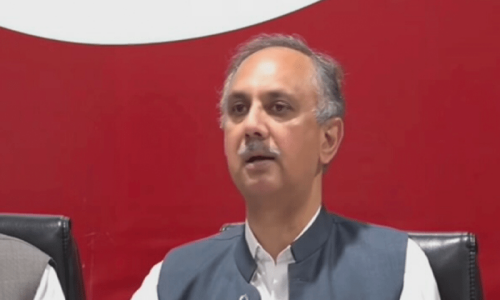The marginalisation and stigmatisation associated with disability have created unjust barriers to inclusion: a person with a disability is left disempowered, not just educationally and socially but also economically. Even if one ignores the ugly social dimension, the exclusion of this segment incurs a high cost to the economy, estimated at about Rs127 billion annually in Pakistan.
To add insult to injury, the money trail of around Rs7 million reported in the account of the Disabled Persons Rehabilitation Fund in 2014 and its utilisation could not be traced.
The World Report on Disability (WRD) for 2011 estimates that more than one billion people across the globe have some form of disability. One out of every seventh person you come across is likely a person with a disability (PWD).
Excluding people with disabilities incurs a high cost to the economy of at about Rs127 billion annually
Moving from the margins: Mainstreaming persons with disabilities in Pakistan, the Economist Intelligence Unit’s report produced for the British Council, emphasised the impact of this economic curtailment on the nation. In 2014, a loss of around $11.9bn to $15.4bn, or 4.9-6.6 per cent was incurred to the Gross Domestic Product (GDP) by excluding PWDs from the workforce. This figure could surpass $21.4bn by 2018.
Meanwhile, the government and local authorities have done deplorably little in the way of alleviating the burden of what is known as Pakistan’s largest minority. As a matter of fact, results of the population census 2017 served to further erase the presence of PWDs.
Our population was calculated to be 207.7 million, witnessing a staggering rise of 57pc from the 132.3m of the 1998 census. However, somewhat miraculously, PWDs have declined to 0.48pc from 2.54pc previously. This is in stark contrast to the current annual growth rate of disability which is 2.65pc per annum. It then stands to reason that in a developing country such as ours, ravaged by terrorism, disease, and consanguineous marriages, this estimate would be much higher.
Undoubtedly, the census data is severely misleading. The chief statistician of the Pakistan Bureau of Statistics (PBS), Asif Bajwa, has himself reportedly been quoted as saying that the figures “could not be treated as being perfectly realistic”.
The National Report on the census also addresses the inaccuracy by claiming that enumerators felt it was not “culturally sensitive” to ask people about the number or prevalence of PWDs in their households. Further detailed surveys were promised earlier, but there is an unsurprising dearth of updates on the situation. PBS officials, despite repeated requests, did not entertain questions regarding the issue.
These numbers are essential for organisations working for PWDs, imperative for policymaking and budget allocation. Dr Maryam Mallick, technical adviser on disabilities and rehabilitation at World Health Organisation (WHO) Pakistan, lamented the puzzling outcome of the census. She spoke about a Model Disability Survey carried out by the WHO in 2015 in Attock district, Punjab.

“It was based on international standards; we followed the International Classification of Functioning, Disability and Health. Analysis of the data was done by the Public Health and Health Services Research Unit, Munich, Germany. According to it, the percentage of persons with disabilities was 15.5pc. And this is not national data, just district data.”
Dr Mallick also informed this writer about a similar upcoming Model Disability Survey of the WHO for the whole province of Punjab in coordination with the government. She was optimistic about future cooperation and admitted that “the government is showing commitment now, more than before”.
Many legal barricades also exist to employment. The job quota for PWDs was two per cent, according to the Disabled Persons (Employment and Rehabilitation) Ordinance of 1981, the state’s only comprehensive legislature of its kind.
After the 18th Constitutional Amendment in 2010, legislative powers were devolved to the provinces. For Punjab, the quota was increased to 3pc, whereas in Sindh it was reportedly raised to 5pc. Balochistan and Khyber Pakhtunkhwa have kept it at 2pc.
The provincial governments are expected to rehabilitate PWDs, and for such a purpose a number of organisations exist, but mostly on paper. Ergo, the role has been taken over by non-governmental organisations (NGO).
Karim Navroz Ali, manager of administration and finance at the Network of Organisations Working for People with Disabilities, Pakistan (NOWPDP), elaborated on the job quota: “Our interaction with people with disabilities shows that the implementation of the quota is very low. There is no official body to assess it either. At the government level, they are hired as peons or for clerical positions, mostly a political appointment.”
For 100 employees, companies are obligated to hire at least two PWDs. The consequence of not doing so is the payment of a fine worth the minimum wage of one employee — Rs15,000, into the Disabled Persons Rehabilitation Fund. “No companies pay as per my knowledge,” Mr Ali added.
”In Sindh, the Social Welfare Department exists for the collection of such funds, but hardly anyone pays into it.”
Attempts to trace the funds have so far been unsuccessful. The British Council’s report deemed it to be as high as Rs7m in 2014. There is no official mechanism or regulatory body to assess what the current amount is. The pertinent question remains unanswered: where is the money?
Published in Dawn, The Business and Finance Weekly, December 4th, 2017












































